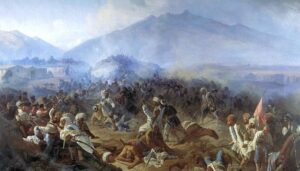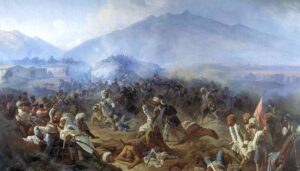 Russia’s interest in the Caucasus was built during the reign of Ivan the Terrible. But the unfolding socio-political processes in Russia at the end of XVI and the beginning of XVII centuries did not allow the upstream development of Caucasus policy of Romanov Russia. XVII century was a turning point in the East-West confrontation. Post-Karlovitsk rubicon changed the foundations of the international system of the continent. The Emperor-reformer – Peter I, abandoning the stagnation positions of the Old Rus, joined Europe in order to strengthen Russia’s position in the international system, launching a policy of conquest.
Russia’s interest in the Caucasus was built during the reign of Ivan the Terrible. But the unfolding socio-political processes in Russia at the end of XVI and the beginning of XVII centuries did not allow the upstream development of Caucasus policy of Romanov Russia. XVII century was a turning point in the East-West confrontation. Post-Karlovitsk rubicon changed the foundations of the international system of the continent. The Emperor-reformer – Peter I, abandoning the stagnation positions of the Old Rus, joined Europe in order to strengthen Russia’s position in the international system, launching a policy of conquest.
Russia, by defeating Charles XII during the Great Northern War (1700-1721), took possession of the Baltic Sea and has become a maritime power. But European countries have become a barrier to the further advancement of Russia to the west, and Peter I activated Russian policy in the Caucasus, in the area of the coastal strip of the Caspian Sea. The interest of the Russian Emperor in the coastal strip of the Caspian Sea was due to rich natural resources, which could give new impetus to the development of the Russian economy. At the same time, Peter I also tried to form an ethno-confessional basis, for the establishment of Russia’s political position in the region, decided to bet on the “Armenian issue”, the idea of “Great Armenia” invented by Mkhitarists and featured by Armenianfalsifiers. Here, the Armenian-Gregorian church acted as the “first violin”. Already at the beginning of the Northern War, the representative of the Armenian Gregorian Church I.Ori met with Peter I and drew the attention of the Russian tsar to “Armenian issue”, developing a fictitious map of Armeniaaccording to the algorithm of the Armenian Gregorian Church, directs him to Azerbaijani Irevan fortress, at the same time convinces the emperor about advisability of Asia Minor route, that opens the way to Istanbul, where the Christian population of this choronim would be social support for theRussian troops. After receiving this information, Peter I, during the Northern War, developed the contours of Caucasian policy and made plans for the upcoming military operations with states that dominate in the region. When designing grandiose plans for the Caspian lands, as strategically important for Russia, Tsar considered it expedient to form ethno-social basis for his political power in this confessional Muslim area. And for this purpose, Peter I planned the formation of a “united under the scepter of Russia the Georgian-Armenian alliance led by the Georgian king (ruler of Kartli-Kakheti kingdom-ed.) Vakhtang VI, with the intention of turning it into an outpost in the South Caucasus.
In the policy of the Christianization of the conquered lands, the emperor included not only the formation of units of the Armenian-Georgian Christian Union. During the Caspian campaign, Peter I, not concealing his plans of Christianization, planned an “ethnic cleansing” of the cities of the coast of the Caspian Sea, evicting the autochthonous population of Azerbaijan – Azerbaijanis – from these lands, in order to prevent the influence of the Ottoman factor in the region, which intensified after the Shamakhi events in 1721.
The international situation and the domestic political situation in the Empire did not allow Peter I to realize his targeted plans of integral Caucasus policy, the Christian colonization of the Caspian coast strip. As a result of the Caspian campaign of Peter I, the Istanbul agreement was signed in 1724, establishing the Russian conquest of the lands on the Caspian coast. However, after the death of Peter I, the “bironovshchina”, established in Russia during the reign of Anna Ivanovna, was not interested in the issue of the Caucasus, and Russia, by signing Rasht (1732) and Ganja (1735) agreements, easily abandoned Peter’s policies in the Caucasus.
Source // “International Academic Herald” 2014 »5 (5) // .pp. 4-11
Hajar Verdiyeva Doctor of Historical Science.
